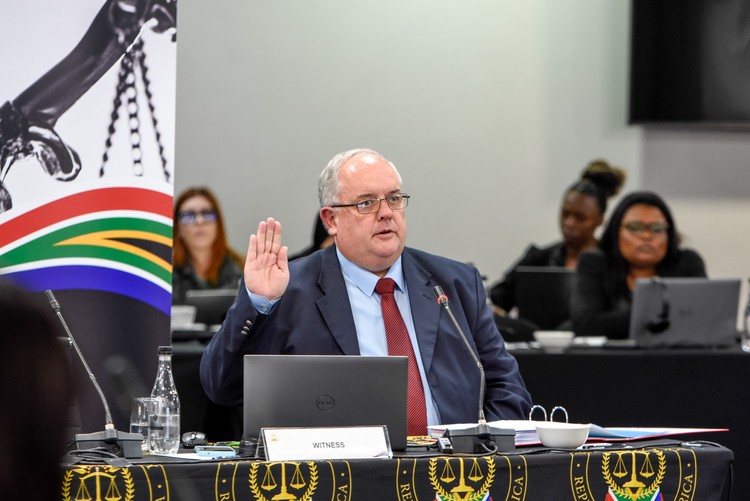
5 May 2025
Digital forensic analyst Francois Moller being sworn in at the Judicial Conduct Tribunal. Photo: Office of the Chief Justice
There is no forensic evidence that Eastern Cape Judge President Selby Mbenenge sent a picture of his penis to a junior clerk, the Judicial Conduct Tribunal heard on Monday.
The tribunal is hearing a complaint of sexual harassment against Mbenenge. During the previous tribunal proceedings earlier this year, the panel, chaired by retired Judge Bernard Ngoepe, heard evidence from Andiswa Mengo of how the judge sent her reams of sexually laden messages and emojis which she said were sexually explicit.
She claimed that this unwanted attention included him sending her a picture of his “private parts” on WhatsApp and asking her for oral sex in his chambers.
Judge Mbenenge has admitted to “consensual” conversations with her, but denied the incident in his chambers or sending her the picture.
On Monday, digital forensic analyst Francois Moller was called to the witness stand by evidence leader Salome Scheepers.
He said he had been given two devices to analyse, one belonging to Mbengene and the other to Mengo. Mbenegene’s phone appeared to have been wiped clean of all messages but hundreds remained on Mengo’s phone.
Mengo had previously provided a “screengrab” of the photo of a penis, allegedly sent to her by Mbenenge. She said that she had received it on 20 June 2021, before Mbenenge deleted it.
The screengrab appeared to be “cropped” in that it did not contain a date, or any other information, just the time of 9:05 am.
Moller explained that even deleted Whatsapp messages and those that had been “deleted for all” can remain on a device but this was dependent on data capacity and eventually they would be “overwritten”.
Under cross examination, Griffits Madonsela, the advocate acting for Mbenenge, said while the screengrab showed no date, it did show the time. He asked Moller to use his software to determine if any message was exchanged between Mbenenge and Mengo on any date at 9:05 am.
After doing the search, Moller said there were no matches. “At the time of my investigation it was not there anymore,” he said.
Regarding Mengo’s testimony that the picture had been sent to her on 20 June 2021, Madonsela again asked Moller to search for messages on that day.
He said there were “quite a few”. Some just past 6am and then others late at night.
“So there was nothing during the day?” Madonsela asked.
Moller responded, “Not saved to the device, no. I cannot comment on deleted information. I am just saying what I found on the device.”
He said either Mengo or Mbenenge could have deleted it.
“If it gets deleted there is no entry of that on the device. And if new data comes in and overrides it, it’s gone.” He said it was not possible to detect if a message had been deleted and then overwritten.
Given the lack of information on the screengrab, Moller said it could have been edited.
But Advocate Nasreen Rajab-Budlender, representing complainant Andiswa Mengo on behalf of the Women’s Legal Centre, asked: “The fact that you did not find a message or screenshot on her phone does not mean it does not exist?”
Moller responded: “Yes”.
The tribunal is scheduled to sit until 16 May. After hearing all the evidence, the tribunal will have to decide whether or not to recommend to the Judicial Service Commission that Mbenenge is guilty of gross misconduct, a finding which could lead to his impeachment.